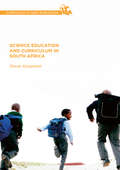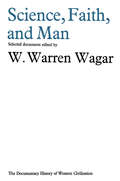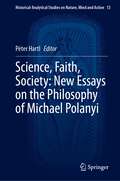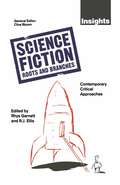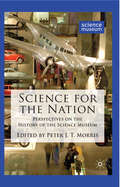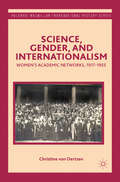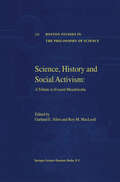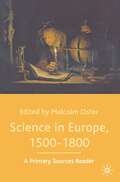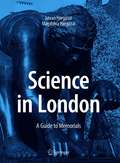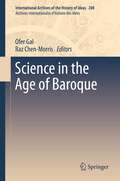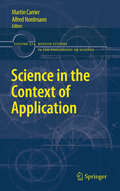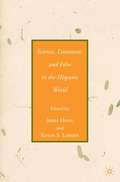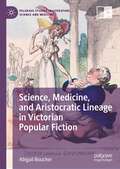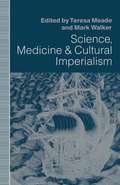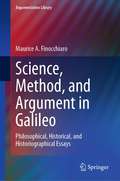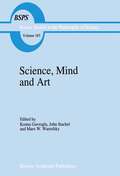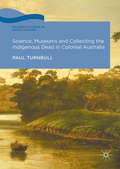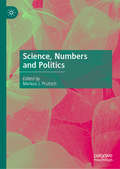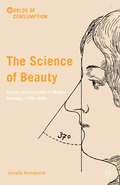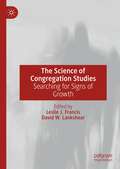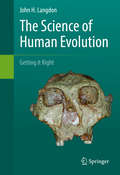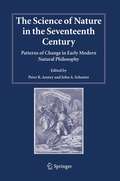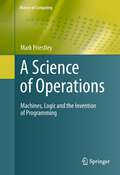- Table View
- List View
Science Education and Curriculum in South Africa
by Oscar KoopmanThis book explores the impact of the socio-historical, political, and economic environment in South Africa, both during and after Apartheid. During this time, the South African education system demonstrated an interest in a specific type of knowledge, which Koopman refers to as ‘a science of government’. This ‘science of government’ leaves the learners with a blurred understanding of science that is disconnected from external nature and human nature, and is presented as a series of abstract concepts and definitions. The book also investigates the dialectical tensions between the science curriculum and the role of the teacher as an active implementer of the curriculum. The book draws on the work of various phenomenological scholars, namely Edmund Husserl, Martin Heidegger, Merleau-Ponty, and Max van Manen to discuss these tensions.
Science Education and Curriculum in South Africa
by Oscar KoopmanThis book explores the impact of the socio-historical, political, and economic environment in South Africa, both during and after Apartheid. During this time, the South African education system demonstrated an interest in a specific type of knowledge, which Koopman refers to as ‘a science of government’. This ‘science of government’ leaves the learners with a blurred understanding of science that is disconnected from external nature and human nature, and is presented as a series of abstract concepts and definitions. The book also investigates the dialectical tensions between the science curriculum and the role of the teacher as an active implementer of the curriculum. The book draws on the work of various phenomenological scholars, namely Edmund Husserl, Martin Heidegger, Merleau-Ponty, and Max van Manen to discuss these tensions.
Science, Faith, Society: New Essays on the Philosophy of Michael Polanyi (Historical-Analytical Studies on Nature, Mind and Action #13)
by Péter HartlThe book is arguably the first comprehensive collection of essays on Michael Polanyi’s social, political philosophy. The essays combine philosophical and historical approaches to show Polanyi’s social thought in the context of his epistemology and philosophy of science as well as the 20th century intellectual history. This volume appeals to specialists in Michael Polanyi’s philosophy, political philosophers who are interested in the 20th century political thought, mainly conservative-liberal political tradition. Furthermore it appeals to scholars focusing on the intersections between epistemology and political philosophy.
Science Fiction Roots And Branches: Contemporary Critical Approaches (Insights)
by Rhys Garnett R J EllisScience for the Nation: Perspectives on the History of the Science Museum
by P. MorrisAn engaging study of a great national institution. Essays explore the changing roles of museums and the perceived public role of a museum of science and technology. Illuminates the ways in which we think about the collecting and display of objects and the often difficult relations between the state, business and industry, and museum funding.
Science, Gender, and Internationalism: Women’s Academic Networks, 1917-1955 (Palgrave Macmillan Transnational History Series)
by Christine von OertzenFounded in 1920, the International Federation of University brought together women committed to promoting higher education across divisions hardened by global conflict. Here, Christine von Oertzen traces the IFUW's international rise and Cold War decline, making a valuable contribution to the cultural, diplomatic, and intellectual history.
Science, History and Social Activism: A Tribute to Everett Mendelsohn (Boston Studies in the Philosophy and History of Science #228)
by Roy M. MacLeod Garland E. Allen"To earn a degree, every doctoral candidate should go out to Harvard Square, find an audience, and explain his [or her] dissertation". Everett Mendelsohn's worldly advice to successive generations of students, whether apocryphal or real, has for over forty years spoken both to the essence of his scholarship, and to the role of the scholar. Possibly no one has done more to establish the history of the life sciences as a recognized university discipline in the United States, and to inspire a critical concern for the ways in which science and technology operate as central features of Western society. This book is both an act of homage and of commemoration to Professor Mendelsohn on his 70th birthday. As befits its subject, the work it presents is original, comparative, wide-ranging, and new. Since 1960, Everett Mendelsohn has been identified with Harvard Univer sity, and with its Department of the History of Science. Those that know him as a teacher, will also know him as a scholar. In 1968, he began- and after 30 years, has just bequeathed to others - the editorship of the Journal of the History of Biology, among the earliest and one of the most important publications in its field. At the same time, he has been a pioneer in the social history and sociology of science. He has formed particularly close working relationships with colleagues in Sweden and Germany - as witnessed by his editorial presence in the Sociology of Science Yearbook.
Science in Europe, 1500-1800: A Primary Sources Reader
by Malcolm OsterThe period from Copernicus to Newton witnessed a Scientific Revolution which eventually led to modern science and both built upon and sharply challenged the earlier natural philosophies of the classical world. Science in Europe, 1500-1800: A Primary Sources Readeroffers a fascinating picture of the world of the scientific revolution through the eyes of those involved. This selection of primary sources is geographically inclusive, including often-neglected areas such as Spain, Scandinavia and central-eastern Europe, and thematically wide-ranging, illustrating early modern Europe's interplay of social, cultural and intellectual traditions.A key resource for all students and teachers of the history of science, Malcolm Oster's masterly collection offers an introduction to the conceptual and institutional foundations of modern science.This volume can be used alongside or independently of its companion volume, Science in Europe: 1500-1800: A Secondary Sources Reader (also edited by Malcolm Oster).
Science in London: A Guide to Memorials
by Istvan Hargittai Magdolna HargittaiThis book introduces the reader to the statues, busts, and memorial plaques of scientists, explorers, medicine men and women, and inventors found in the bustling capital of the United Kingdom, London. The former capital of the British Empire, London remains a world center of trade, navigation, finance and many more. It is also a hub of science, the seat of the Royal Society, Royal Institution, Science Museum, British Museum, Natural History Museum, and of great institutions of higher education. The historical figures depicted in these memorials are responsible for creating great institutions, milestone discoveries, contributions to the scientific and technological revolutions, fighting against epidemics, advancing medicine, and contributing to the progress seen during the past four hundred years. This is a guidebook for the visitor and the Londoner alike. It presents memorials that everybody is familiar with and others that the authors discovered during their years of painstaking research. The 750 images and the text, interlarded with anecdotes, is both informative and entertaining.
Science in the Age of Baroque (International Archives of the History of Ideas Archives internationales d'histoire des idées #208)
by Ofer Gal and Raz Chen-MorrisThis volume examines the New Science of the 17th century in the context of Baroque culture, analysing its emergence as an integral part of the high culture of the period. The collected essays explore themes common to the new practices of knowledge production and the rapidly changing culture surrounding them, as well as the obsessions, anxieties and aspirations they share, such as the foundations of order, the power and peril of mediation and the conflation of the natural and the artificial. The essays also take on the historiographical issues involved: the characterization of culture in general and culture of knowledge in particular; the use of generalizations like ‘Baroque’ and the status of such categories; and the role of these in untangling the historical complexities of the tumultuous 17th century. The canonical protagonists of the ‘Scientific Revolution’ are considered, and so are some obscure and suppressed figures: Galileo side by side with Scheiner;Torricelli together with Kircher; Newton as well as Scilla. The coupling of Baroque and Science defies both the still-triumphalist historiographies of the Scientific Revolution and the slight embarrassment that the Baroque represents for most cultural-national histories of Western Europe. It signals a methodological interest in tensions and dilemmas rather than self-affirming narratives of success and failure, and provides an opportunity for reflective critique of our historical categories which is valuable in its own right.
Science in the Context of Application (Boston Studies in the Philosophy and History of Science #274)
by Martin Carrier and Alfred NordmannWe increasingly view the world around us as a product of science and technology. Accordingly, we have begun to appreciate that science does not take its problems only from nature and then produces technological applications, but that the very problems of scientific research themselves are generated by science and technology. Simultaneously, problems like global warming, the toxicology of nanoparticles, or the use of renewable energies are constituted by many factors that interact with great complexity. Science in the context of application is challenged to gain new understanding and control of such complexity—it cannot seek shelter in the ivory tower or simply pursue its internal quest for understanding and gradual improvement of grand theories. Science in the Context of Application will identify, explore and assess these changes. Part I considers the "Changing Conditions of Scientific Research" and part II "Science, Values, and Society". Examples are drawn from pharmaceutical research, the information sciences, simulation modelling, nanotechnology, cancer research, the effects of commercialization, and many other fields. The book assembles papers from well-known European and American Science Studies scholars like Bernadette Bensaude-Vincent, Janet Kourany, Michael Mahoney, Margaret Morrison, Hans-Jörg Rheinberger, Arie Rip, Dan Sarewitz, Peter Weingart, and others. The individual chapters are written to address anyone who is concerned about the role of contemporary science in society, including scientists, philosophers, and policy makers.
Science, Literature, and Film in the Hispanic World
by J. Hoeg K. LarsenDriven by such diverse advances as the Human Genome Project and the explosion of the World Wide Web, and also by the threat of human-inspired disasters such as global warming, the field of science and literature studies is currently undergoing an unprecedented expansion. The relations between science and literature have been and continue to be central to understanding Hispanic civilization and culture. In spite of this, Science, Literature, and Film in the Spanish-Speaking World is the first and only book to treat this new and dynamic field from an Hispanic perspective. This unique volume opens the door to an entirely new focus in the study of Hispanic literature and culture.
Science, Medicine, and Aristocratic Lineage in Victorian Popular Fiction (Palgrave Studies in Literature, Science and Medicine)
by Abigail BoucherScience, Medicine, and Lineage in Popular Fiction of the Long Nineteenth Century explores the dialogue between popular literature and medical and scientific discourse in terms of how they represent the highly visible an pathologized British aristocratic body. This books explores and complicates the two major portrayals of aristocrats in nineteenth-century literature: that of the medicalised, frail, debauched, and diseased aristocrat, and that of the heroic, active, beautiful ‘noble’, both of which are frequent and resonant in popular fiction of the long nineteenth century. Abigail Boucher argues that the concept of class in the long nineteenth century implicitly includes notions of blood, lineage, and bodily ‘correctness’, and that ‘class’ was therefore frequently portrayed as an empirical, scientific, and medical certainty. Due to their elevated and highly visual social positions, both historical and fictional aristocrats were frequently pathologized in the public mind and watched for signs of physical excellence or deviance. Using popular fiction, Boucher establishes patterns across decades, genres, and demographics and considers how these patterns react to, normalise, or feed into the advent of new scientific and medical understandings.
Science, Medicine and Cultural Imperialism
by Teresa A. Meade Mark WalkerA text which describes the ways that European powers used science and scientific inquiry to enforce their supposed cultural superiority on societies of Africa, Asia and Latin America.
Science, Method, and Argument in Galileo: Philosophical, Historical, and Historiographical Essays (Argumentation Library #40)
by Maurice A. FinocchiaroThis book collects a renowned scholar's essays from the past five decades and reflects two main concerns: an approach to logic that stresses argumentation, reasoning, and critical thinking and that is informal, empirical, naturalistic, practical, applied, concrete, and historical; and an interest in Galileo’s life and thought—his scientific achievements, Inquisition trial, and methodological lessons in light of his iconic status as “father of modern science.” These republished essays include many hard to find articles, out of print works, and chapters which are not available online. The collection provides an excellent resource of the author's lifelong dedication to the subject. Thus, the book contains critical analyses of some key Galilean arguments about the laws of falling bodies and the Copernican hypothesis of the earth’s motion. There is also a group of chapters in which Galileo’s argumentation is compared and contrasted with that of other figures such as Socrates, Karl Marx, Giordano Bruno, and his musicologist father Vincenzo Galilei. The chapters on Galileo’s trial illustrate an approach to the science-vs-religion issue which Finocchiaro labels “para-clerical” and conceptualizes in terms of a judicious consideration of arguments for and against Galileo and the Church. Other essays examine argumentation about Galileo’s life and thought by the major Galilean scholars of recent decades. The book will be of interest to scholars in philosophy, logic, philosophy of science, history of science, history of religion, philosophy of religion, argumentation, rhetoric, and communication studies.
Science, Mind and Art: Essays on science and the humanistic understanding in art, epistemology, religion and ethics In honor of Robert S. Cohen (Boston Studies in the Philosophy and History of Science #165)
by Marx W. Wartofsky JohnStachel KostasGavrogluIn three volumes, a distinguished group of scholars from a variety of disciplines in the natural and social sciences, the humanities and the arts contribute essays in honor of Robert S. Cohen, on the occasion of his 70th birthday. The range of the essays, as well as their originality, and their critical and historical depth, pay tribute to the extraordinary scope of Professor Cohen's intellectual interests, as a scientist-philosopher and a humanist, and also to his engagement in the world of social and political practice. Science, Mind and Art, Volume III of Essays in honor of Robert S. Cohen focuses on issues in contemporary epistemology, aesthetics, and philosophy of mind as well as on the relations of science and human values in ethical and religious thought. It also has important new work in contemporary metaphysics, as well as in the history of philosophy, and on questions of multiculturalism in science education. Contributors include Paul Feyerabend, Adolf Grünbaum, Joseph Margolis, Joëlle Proust, Erazim Kohak, Elie Wiesel, Miriam Bienenstock, and John Silber, among others.
Science, Museums and Collecting the Indigenous Dead in Colonial Australia
by Paul TurnbullThis book draws on over twenty years’ investigation of scientific archives in Europe, Australia, and other former British settler colonies. It explains how and why skulls and other bodily structures of Indigenous Australians became the focus of scientific curiosity about the nature and origins of human diversity from the early years of colonisation in the late eighteenth century to Australia achieving nationhood at the turn of the twentieth century. The last thirty years have seen the world's indigenous peoples seek the return of their ancestors' bodily remains from museums and medical schools throughout the western world. Turnbull reveals how the remains of the continent's first inhabitants were collected during the long nineteenth century by the plundering of their traditional burial places. He also explores the question of whether museums also acquired the bones of men and women who were killed in Australian frontier regions by military, armed police and settlers.
Science, Museums and Collecting the Indigenous Dead in Colonial Australia
by Paul TurnbullThis book draws on over twenty years’ investigation of scientific archives in Europe, Australia, and other former British settler colonies. It explains how and why skulls and other bodily structures of Indigenous Australians became the focus of scientific curiosity about the nature and origins of human diversity from the early years of colonisation in the late eighteenth century to Australia achieving nationhood at the turn of the twentieth century. The last thirty years have seen the world's indigenous peoples seek the return of their ancestors' bodily remains from museums and medical schools throughout the western world. Turnbull reveals how the remains of the continent's first inhabitants were collected during the long nineteenth century by the plundering of their traditional burial places. He also explores the question of whether museums also acquired the bones of men and women who were killed in Australian frontier regions by military, armed police and settlers.
Science, Numbers and Politics
by Markus J. PrutschThis study explores the dynamic relationship between science, numbers and politics. What can scientific evidence realistically do in and for politics? The volume contributes to that debate by focusing on the role of “numbers” as a means by which knowledge is expressed and through which that knowledge can be transferred into the political realm. Based on the assumption that numbers are constantly being actively created, translated, and used, and that they need to be interpreted in their respective and particular contexts, it examines how numbers and quantifications are made ‘politically workable’, examining their production, their transition into the sphere of politics and their eventual use therein. Key questions that are addressed include: In what ways does scientific evidence affect political decision-making in the contemporary world? How and why did quantification come to play such an important role within democratic politics? What kind of work do scientific evidence and numbers do politically?
The Science of Beauty: Culture and Cosmetics in Modern Germany, 1750–1930 (Worlds of Consumption)
by Annelie RamsbrockWhat did the cosmetic practices of middle-class women in the nineteenth century have in common with the repair of men's bodies mutilated in war? What did the New Woman of the Weimar years have to do with the field of social medicine that emerged in the same period? They were all part of a conversation about the cosmetic modification of bodies, a debate shaped by scientific knowledge and normative social models. Conceived as a cultural history, this book examines the history of artificially created beauty in Germany from the late Enlightenment to the early days of National Socialist rule.
The Science of Congregation Studies: Searching for Signs of Growth
by Leslie J. Francis David W. LankshearDuring the past two decades, the Science of Congregation Studies has blossomed significantly in the UK, as well as within the USA and Australia. In this illuminating and thought-provoking volume, Leslie J. Francis’ research group draws on the Signs of Growth Survey conducted throughout the Anglican Diocese of Southwark to illustrate how the strength of combined qualitative and quantitative research methods can draw on the insights of psychological theory, sociological theory, and empirical theology to illuminate pressing questions of relevance to the sociology of religion, psychology of religion, practical theology and pastoral studies. Individual chapters discuss the missing generation of young people, the greying generation aged seventy and over, how occasional churchgoers express belonging and commitment, connections between psychological type and religious motivation, and the distinctive characteristics of growing congregations.
The Science of Human Evolution: Getting it Right
by John H. LangdonThis textbook provides a collection of case studies in paleoanthropology demonstrating the method and limitations of science. These cases introduce the reader to various problems and illustrate how they have been addressed historically. The various topics selected represent important corrections in the field, some critical breakthroughs, models of good reasoning and experimental design, and important ideas emerging from normal science.
The Science of Nature in the Seventeenth Century: Patterns of Change in Early Modern Natural Philosophy (Studies in History and Philosophy of Science #19)
by Peter R. Anstey John A. SchusterOne of the hallmarks of the modern world has been the stunning rise of the natural sciences. The exponential expansion of scientific knowledge and the accompanying technology that so impact on our daily lives are truly remarkable. But what is often taken for granted is the enviable epistemic-credit rating of scientific knowledge: science is authoritative, science inspires confidence, science is right. Yet it has not always been so. In the seventeenth century the situation was markedly different: competing sources of authority, shifting disciplinary boundaries, emerging modes of experimental practice and methodological reflection were some of the constituents in a quite different mélange in which knowledge of nature was by no means p- eminent. It was the desire to probe the underlying causes of the shift from the early modern ‘nature-knowledge’ to modern science that was one of the stimuli for the ‘Origins of Modernity: Early Modern Thought 1543–1789’ conference held in Sydney in July 2002. How and why did modern science emerge from its early modern roots to the dominant position which it enjoys in today’s post-modern world? Under the auspices of the International Society for Intellectual History, The University of New South Wales and The University of Sydney, a group of historians and philosophers of science gathered to discuss this issue. However, it soon became clear that a prior question needed to be settled first: the question as to the precise nature of the quest for knowledge of the natural realm in the seventeenth century.
A Science of Operations: Machines, Logic and the Invention of Programming (History of Computing)
by Mark PriestleyToday, computers fulfil a dazzling array of roles, a flexibility resulting from the great range of programs that can be run on them.A Science of Operations examines the history of what we now call programming, defined not simply as computer programming, but more broadly as the definition of the steps involved in computations and other information-processing activities. This unique perspective highlights how the history of programming is distinct from the history of the computer, despite the close relationship between the two in the 20th century. The book also discusses how the development of programming languages is related to disparate fields which attempted to give a mechanical account of language on the one hand, and a linguistic account of machines on the other.Topics and features: Covers the early development of automatic computing, including Babbage’s “mechanical calculating engines” and the applications of punched-card technology, examines the theoretical work of mathematical logicians such as Kleene, Church, Post and Turing, and the machines built by Zuse and Aiken in the 1930s and 1940s, discusses the role that logic played in the development of the stored program computer, describes the “standard model” of machine-code programming popularised by Maurice Wilkes, presents the complete table for the universal Turing machine in the Appendices, investigates the rise of the initiatives aimed at developing higher-level programming notations, and how these came to be thought of as ‘languages’ that could be studied independently of a machine, examines the importance of the Algol 60 language, and the framework it provided for studying the design of programming languages and the process of software development and explores the early development of object-oriented languages, with a focus on the Smalltalk project.This fascinating text offers a new viewpoint for historians of science and technology, as well as for the general reader. The historical narrative builds the story in a clear and logical fashion, roughly following chronological order.
